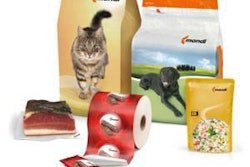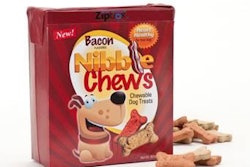Like other experts and analysts, Euromonitor International is bullish on the global pet industry. "Overall retail growth should be stronger than in 2011, with total sales approaching US$95 billion worldwide in 2012," writes Paula Flores, the firm's new global head of pet care research, in a blog. "This represents a year-on-year constant value gain of 2.5%." Her data comes from Euromonitor's latest report on the global pet care market, released earlier this month.
Flores attributes the continued growth -- which is happening, she says, "despite persistent economic uncertainty, mounting troubles in the EuroZone and continued political instability in several emerging markets" -- to the ongoing trends of pet humanization and premiumization. Specifically, she targets treats as a main driver behind the industry's growth. Functional and "added-value" treats (such as cat treats with a high protein level) continue to gain traction around the world, Flores writes.
For example, even in Western Europe, where pet care sales are sluggish, Euromonitor projects cat treat sales to rise 5% this year. Germany is the leader in that region, with the average cat-owning household spending US$44 on treats.
However, Chile is the fastest growing market globally for cat treats, with 22% annual growth, Flores says. Her company expects dog treats to increase 6% in sales globally this year, led by 21% growth in Argentina.
The US remains the largest market worldwide for dog and cat treats, with combined sales of US$2.8 billion. But that market maturity comes at a price: Flores projects dog treat sales in the US to actually decline this year.
I'm assuming Euromonitor is looking at pet care sales in all retain channels. Looking at just the US pet specialty channel (pet shops, including chains and independents; farm and feed stores; and veterinary clinics), GfK Retail and Technology USA shows dog treat sales rose 15.6% from May 2011 through April 2012, with cat treat sales increasing 13.6% in the same period. (Watch for an article in the August issue of Petfood Industry with more information from GfK, including US sales and volume data through May of this year.)
Euromonitor is also out with a sample of its report on the booming Latin American pet market, which Flores refers to as the "world beater." In Brazil, which became the sixth largest economy in the world in 2011, mid-price products now comprise more of the market for both cat and dog food, as "increasingly affluent and confident Brazilian consumers seek out better quality petfood and trade up from economy formats," the report says. Dog food still commands the majority of this market, but cat food shows huge potential as urbanization increases and more Brazilians move into smaller households and, the reasoning goes, will seek smaller pets.
While Argentina represents the fastest growing pet care market in Latin America, it's still fairly small, and inflation in the country remains a concern as cost increases are passed on to pet owners. Dog food accounts for 73% of all pet care retail sales, and 38% of Argentinean households own dogs; yet only 31% of dogs there eat commercially prepared petfood, so the potential for growth is still strong.
Chile is an even smaller pet care market but boast's the region's highest rates of pet ownership, with 60% of households owning dogs and 31% owning cats. Those households spend an average of US$42 annually on pet care, second in the region only to Mexico's US$50 per household.

















